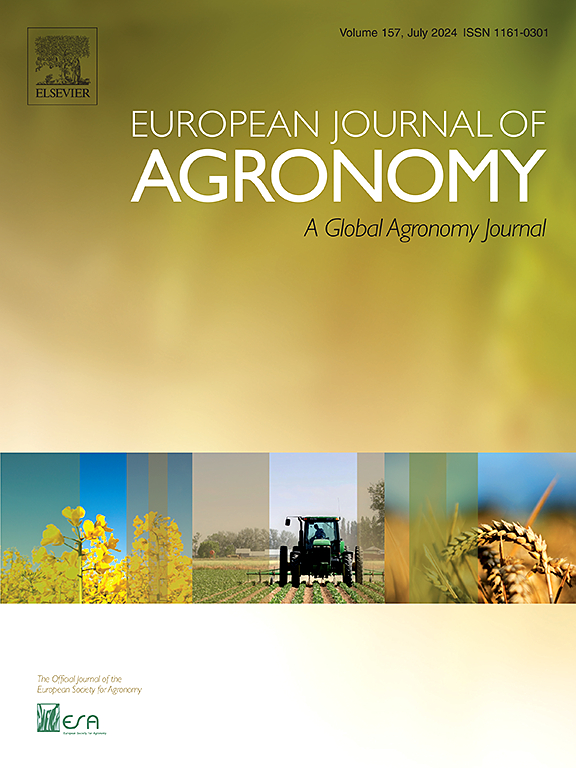周期性秸秆生物炭可提高作物产量,固碳并减轻排放
IF 4.5
1区 农林科学
Q1 AGRONOMY
引用次数: 0
摘要
增加土壤固碳是减少农业系统温室气体(GHG)排放的主要措施之一,秸秆生物炭还田具有增加土壤固碳和作物产量、减少温室气体排放的潜力,但由于投入高,其应用在很大程度上受到限制。目前尚不清楚定期使用秸秆生物炭是否能有效应对这些挑战。为探索在不降低经济效益的前提下实现增产固碳的适宜秸秆还田模式,在黄土高原进行了为期7年的常规耕作、秸秆还田和秸秆还田对冬小麦产量、土壤有机碳含量、温室气体排放和经济效益的影响对比试验。秸秆生物炭处理的7年平均产量最高,比常规耕作和麦秸处理分别提高9.94 %和2.28 %。与常规耕作和麦秸相比,秸秆生物炭处理7年后土壤有机碳含量显著提高24.61 %和12.57 % (p <; 0.05)。此外,与常规耕作和麦秸相比,秸秆生物炭增加了CO2的年累积排放量,但减少了N2O的年累积排放量;秸秆生物炭处理下的全球净变暖潜势降低了7.7倍和1.1倍(p <; 0.05),温室气体排放强度降低了8.6倍和1.6倍(p <; 0.05),这主要是由于秸秆生物炭增加了小麦产量和有机碳,但减少了N2O排放。秸秆生物炭5年累计净收入和累计生态系统净经济效益较常规耕作显著提高12.16 %和20.27 %,7年净生态系统经济效益与小麦秸秆相当(p <; 0.05)。综上所述,我们的研究结果表明,每五年使用一次秸秆生物炭可以有效地增加碳固存和减少温室气体排放,同时保持收入。因此,从经济效益和环境效益两方面考虑,秸秆生物炭定期还田是旱地旱作农业的一种有效方法。本文章由计算机程序翻译,如有差异,请以英文原文为准。
Periodic straw-derived biochar improves crop yield, sequesters carbon, and mitigates emissions
Increasing soil carbon sequestration is one of the main measures to mitigate greenhouse gas (GHG) emissions in agricultural systems, and straw-derived biochar returning has the potential to increase soil carbon sequestration and crop yield, mitigate GHG emissions, but its application is largely restricted due to the high input. It remains unclear whether periodic application of straw-derived biochar could effectively meet these challenges. To explore the appropriate mode of straw-derived biochar returning which aims to achieve the goal of increasing yield and carbon sequestration without reducing economic benefits, a 7-year site experiment was carried out to compare the effects of conventional tillage, wheat straw returning and straw-derived biochar returning on winter wheat yield, soil organic carbon (SOC) contents, GHG emissions and economic benefits on the Loess Plateau of China. The highest average yield over the 7-year experiment was found under straw biochar, and average yield over the 7-year experiment was increased by 9.94 % and 2.28 %, as compared with conventional tillage and wheat straw, respectively. Meanwhile, under straw biochar the SOC content was significantly increased by 24.61 % and 12.57 % than conventional tillage and wheat straw after 7 years (p < 0.05). In addition, compared to conventional tillage and wheat straw, straw biochar increased the annual cumulative CO2 emissions, but reduced the annual cumulative N2 O emissions; the net global warming potential under straw biochar decreased by 7.7 and 1.1 times (p < 0.05), and the greenhouse gas emission intensity decreased by 8.6 and 1.6 times (p < 0.05), those were mainly due to the fact that straw biochar increased wheat yield and SOC, but reduced N2 O emissions. The 5-year cumulative net income and cumulative net ecosystem economic benefits under straw biochar were significantly increased by 12.16 % and 20.27 % compared to the conventional tillage, while the 7-year net ecosystem economic benefits was comparable to the wheat straw (p < 0.05). Taken together, our results suggest that the application of straw-derived biochar every five years could effectively increase carbon sequestration and mitigate GHG emissions, while maintaining the income simultaneously. Therefore, that the periodic straw-derived biochar returning could be an effective approach in rainfed agriculture of dryland, considering both economic and environmental effects.
求助全文
通过发布文献求助,成功后即可免费获取论文全文。
去求助
来源期刊

European Journal of Agronomy
农林科学-农艺学
CiteScore
8.30
自引率
7.70%
发文量
187
审稿时长
4.5 months
期刊介绍:
The European Journal of Agronomy, the official journal of the European Society for Agronomy, publishes original research papers reporting experimental and theoretical contributions to field-based agronomy and crop science. The journal will consider research at the field level for agricultural, horticultural and tree crops, that uses comprehensive and explanatory approaches. The EJA covers the following topics:
crop physiology
crop production and management including irrigation, fertilization and soil management
agroclimatology and modelling
plant-soil relationships
crop quality and post-harvest physiology
farming and cropping systems
agroecosystems and the environment
crop-weed interactions and management
organic farming
horticultural crops
papers from the European Society for Agronomy bi-annual meetings
In determining the suitability of submitted articles for publication, particular scrutiny is placed on the degree of novelty and significance of the research and the extent to which it adds to existing knowledge in agronomy.
 求助内容:
求助内容: 应助结果提醒方式:
应助结果提醒方式:


